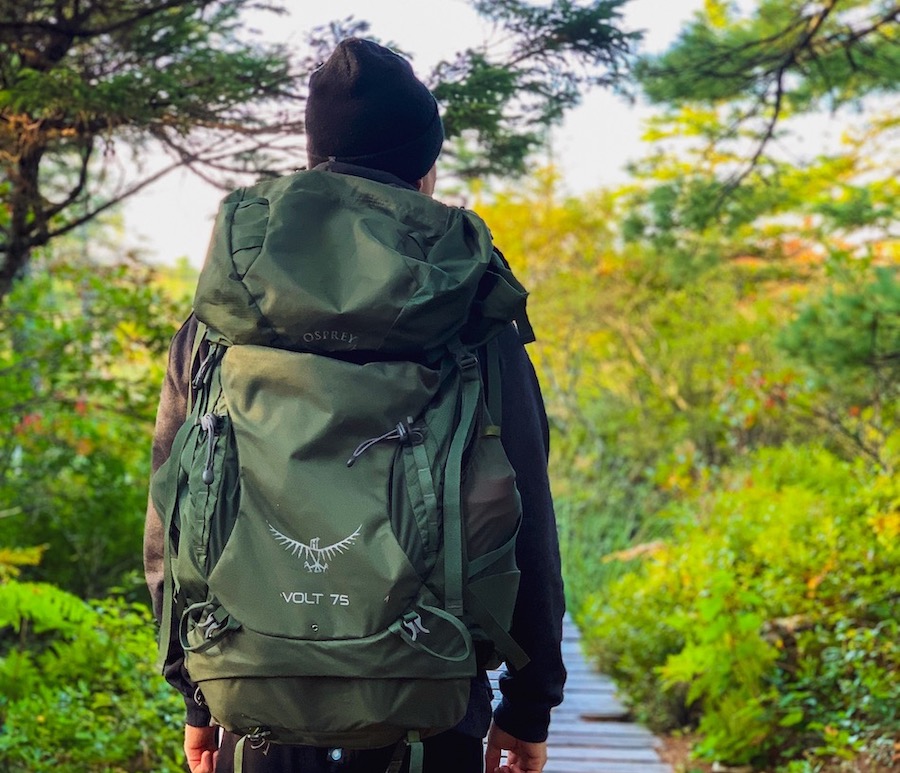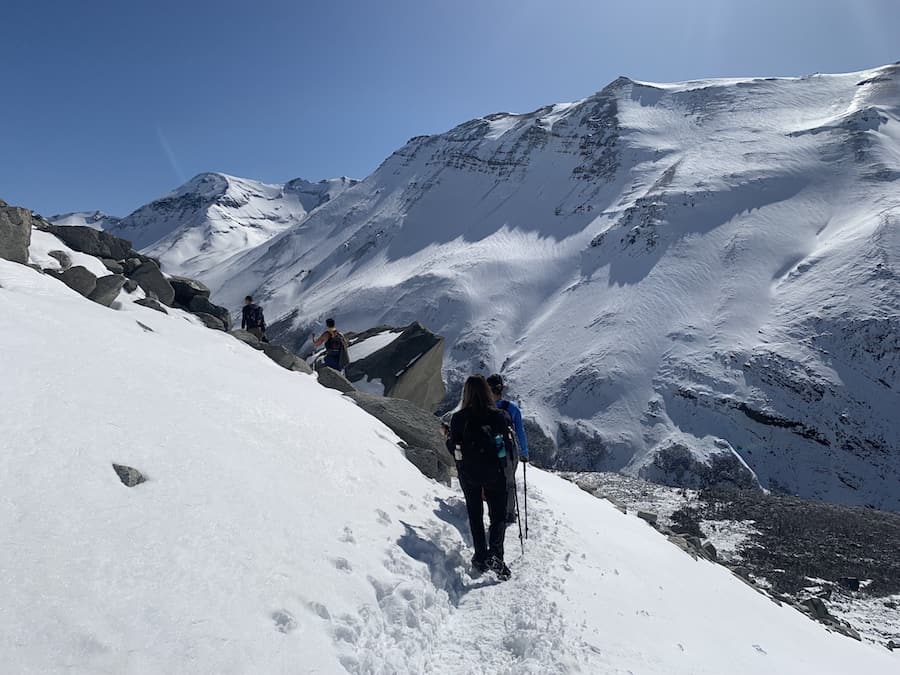Hiking Essentials for Beginners: Starter Guide to the Trails
Are you new to hiking and looking for guidance on what hiking essentials to bring on the trails? Look no further than our hiking guide for beginners. From choosing the right footwear to finding the perfect backpack and understanding trail etiquette – discover the must-know hiking essentials for an unforgettable outdoor experience. We’ll cover all the basics to ensure you’re prepared and safe on your outdoor adventures.
Disclaimer: This article includes affiliate links. If you click one of them, we may receive a small percentage of the sale at no extra cost to you. Thank you for your support!
Building a Solid Hiking Foundation
So, you’re stepping into the world of hiking – fantastic! Before you hit those trails, let’s chat about building a rock-solid foundation for your hiking journey to ensure you are well-prepared and comfortable!
Choosing the Right Footwear

Your feet are your best friends on the trail, so treat them right. When looking for footwear, make sure to prioritize functionality, fit and comfort over style and looks. Choosing the right hiking footwear involves a balance between personal comfort preferences, the type of terrain you’ll be navigating, and the specific demands of your hiking activities. Each person is different. Find footwear that suits your hiking needs, and be sure to try them on prior to buying.
Here are a few things to consider when choosing the right footwear for hiking:
Understand Your Hiking Style
- Day Hikes: Lightweight hiking shoes with good traction are suitable for well-maintained trails and day hikes.
- Backpacking: For longer journeys or challenging terrain, consider mid to high-cut boots that offer ankle support and additional stability.
Assess the Terrain
- Trail Conditions: Determine the primary type of terrain you’ll encounter – whether it’s rocky, muddy, sandy, or a combination. Different conditions require different footwear.
- Weather: Consider the weather conditions. Waterproof or Gore-Tex boots are a good option for wet, muddy and snowy environments.
Footwear Types
- Hiking Shoes: Low-cut, lightweight, and suitable for less demanding trails. These are ideal for day hikes and those who prefer agility over ankle support.
- Hiking Boots: Mid to high-cut, offering more ankle support. Suited for varied terrain, longer hikes, and backpacking.
Fit and Comfort
- Sizing: Ensure a proper fit by trying shoes on at the end of the day when your feet may be slightly swollen. Different brands may vary in their sizing, which is why trying them on in-store is incredibly important!
- Toe Room: There should be enough room for your toes to wiggle without hitting the front of the shoe. Too much pressure can lead to discomfort and blisters.
- Heel Support: Your heel should be snug, preventing any slipping or rubbing. Check for a secure fit around the instep as well.
Consider Boot Cut
- Low-Cut: Offers more freedom of movement and is lighter. Suitable for well-maintained trails and day hikes.
- Mid-Cut: Provides ankle support without restricting movement excessively. Suitable for various terrains and longer hikes.
- High-Cut: Offers maximum ankle support and stability. Ideal for rough terrain and backpacking trips.
Try Before You Buy
- In-Store Fitting: Try hiking boots in-store before purchasing to assess comfort and fit, and ask for assistance from knowledgeable staff to ensure they fit properly.
- Test with Socks: Wear the type of socks you’ll use during hiking when trying on footwear. This ensures a more accurate fit.
Break Them In
- Break-In Period: Allow for time to break in your new footwear before embarking on a long hike. Wear them on shorter walks to ensure they mold to your feet and to avoid any foot discomfort.
Layering
Laying is a great way to make sure you are prepared and ready for the trail. For cooler climates, start with a moisture-wicking base layer, add an insulating layer for warmth, such as a fleece, and top it off with a waterproof shell.
If you are hiking in warmer climates, then opt for a lightweight and breathable base layer to wick sweat, such as a moisture-wicking T-shirt or tank top. We still encourage you to bring a waterproof shell, as you never know when the weather will suddenly change.
Choosing The Right Backpack

Choosing the right backpack is a personal decision influenced by your hiking style, preferences, comfort and the type of hike. Your backpack contains all your hiking essentials, such as water, a water filter, snacks and an emergency first aid kit. Take your time, do thorough research and invest in a backpack that aligns with your specific needs to ensure you have a comfortable hiking experience.
Here are a few things to consider when choosing the right backpack for your adventure:
Consider Your Hike Duration and Type
- Day Hikes: Opt for a smaller backpack (20-30 litres) to carry essentials like water, snacks, a first aid kit, and additional layers.
- Overnight Hikes: A medium-sized pack (30-50 litres) should provide ample space for extra clothing, a sleeping bag, and a compact stove for overnight trips.
- Multi-Day Hikes: For longer trips, invest in a larger backpack (50 litres and above) with multiple compartments for organizing gear and accommodating bulkier items like a tent and extra clothing.
Focus on Fit
- Torso Length: Measure your torso length and choose a backpack that matches. Most backpacks are available in different sizes to ensure a proper fit.
- Hip Belt: A well-padded hip belt should sit comfortably on your hips, transferring the majority of the pack’s weight to reduce strain on your shoulders.
- Adjustability: Look for a backpack with adjustable shoulder straps and hip belts to tailor the fit according to your body shape.
Capacity and Organization
- Main Compartment: Consider the main compartment’s size and shape. Some backpacks have a top-loading design, while others offer front or side access for easier packing and access to your gear.
- Pockets and Compartments: Opt for a backpack with multiple pockets and compartments to help organize and separate your gear. This is especially useful for finding items quickly on the trail.
- Hydration Compatibility: Check if the backpack is compatible with a hydration system, allowing you to stay hydrated without having to dig for a water bottle.
Weight of the Backpack
- Material: Look for durable yet lightweight materials. Backpacks with high-denier nylon or polyester are sturdy and can withstand rough conditions without adding unnecessary weight.
- Frame Type: Choose between internal and external frames. Internal frames are sleeker and better for rugged trails, while external frames offer more breathability but are bulkier.
Weather Resistance
- Rain Cover: Consider a backpack with an integrated rain cover or purchase a separate one to protect your gear in case of unexpected rain.
- Water-Resistant Zippers: Opt for backpacks with water-resistant zippers to further shield your belongings from moisture.
Try Before You Buy
- In-Store Fitting: Visit a store to try on different backpacks. Load them with weight to simulate hiking conditions and assess how they feel on your back and hips.
- Adjustability: Ensure that the backpack is easily adjustable and that you can achieve a snug fit with minimal effort.
Stay Hydrated

Staying hydrated on a hike is not just a matter of comfort; it’s a crucial factor that directly impacts your overall well-being and hiking performance. Bringing enough water will make or break your hike.
For shorter day hikes, a smaller hydration pack (around 1.5 to 2 litres) might suffice. Longer treks or backpacking trips may necessitate larger capacities, reaching up to 3 litres or more. Understand your water consumption needs and match them to the pack’s capacity. We recommend bringing a water filter on your hike if the trail has water access points to save space in your pack.
A good rule of thumb is 1 litre of water for every 2 hours of hiking. Of course, this may vary depending on the temperature and difficulty of the trail.
Fueling Your Adventure: Snack Smart, Hike Happy

Fueling your body with the right snacks is important for an enjoyable and energized hiking experience. Opt for portable, nutrient-dense options that provide a quick boost of energy without weighing you down. Consider packing a mix of:
- Trail Mix: A versatile blend of nuts, seeds, dried fruits, and perhaps a touch of dark chocolate provides a satisfying mix of healthy fats, protein, and carbohydrates.
- Energy Bars: Choose bars with a good balance of protein and carbohydrates. Look for options with natural ingredients to keep you fueled without unnecessary additives.
- Fresh Fruit: Apples, oranges, or bananas are convenient, refreshing, and packed with natural sugars for a quick energy pick-me-up.
- Nut Butters: Single-serve nut butter packets pair well with crackers or fruit, offering a dose of healthy fats and protein.
- Jerky: Whether it’s beef, turkey, or plant-based, jerky is a lightweight, protein-packed snack that doesn’t require refrigeration.
- Granola or Cereal Bars: These bars often contain a mix of grains, nuts, and dried fruits, providing a convenient source of energy.
- Dried Seaweed or Veggie Chips: For a savoury option, consider lightweight and crispy snacks that add variety to your hiking fuel.
- Hard Cheese: Pack small portions of hard cheese like cheddar or gouda for a protein and calcium boost.
- Dark Chocolate: A square or two of dark chocolate can satisfy sweet cravings while providing antioxidants and a bit of caffeine.
A well-planned assortment of snacks ensures you have the energy and motivation to conquer the trail while enjoying the great outdoors.
When choosing snacks, be sure to follow the Leave No Trace Principles by taking out everything you bring in and not leaving any food or waste behind.
Planning Your Route
Picture this: You’re on a beautiful trail, the sun is shining, the birds are singing, and suddenly, you realize you have no idea where you are. Not the ideal hiking experience, right? Plan your route before you hit the trailhead. Maps, trail guides, and apps are your new best friends.
AllTrails is a great free option to see trails before you head out. You can also upgrade to AllTrails+, which lets you download maps for offline use.
So, there you have it – your starter pack for building a solid hiking foundation. Choosing the right footwear, mastering the art of layering, finding the right backpack, staying hydrated, fueling smartly, and planning your route are the essentials for a successful hike. Now, to learn trail etiquette!
To learn more about what to bring on your first hiking adventure, check out this ultimate hiking checklist at Kühl!
Trail Etiquette 101

Embarking on a hiking adventure is not just about conquering trails and enjoying nature; it’s also about being a responsible and considerate trail user. Trail etiquette is the unwritten code that ensures everyone’s safety and enjoyment on the path. Here’s your guide to being a courteous hiker:
Stay on the Trail
Stick to designated trails to preserve the natural environment. Avoid creating new paths or taking shortcuts, as this can lead to erosion and disrupt the local ecosystem.
Passing Other Hikers
When overtaking fellow hikers, announce your presence with a friendly greeting or a simple “excuse me.” Pass on the left whenever possible and give others enough space.
Be Mindful of Noise
Many hikers seek tranquillity and the sounds of nature. While it is important to make some noise to let wildlife know you are in the area, avoid blasting music when other hikers are around trying to enjoy the trails as well. If you need to use headphones, keep the volume low and stay aware of your surroundings.
Control Your Pets
If hiking with pets, keep them on a leash and under control (unless a sign specifies it is an off-leash area). Not everyone is comfortable around animals, and wildlife can be disturbed by unleashed pets, leading to injuries.
Leave No Trace
Leave no trace is important to follow whenever you are out in nature. Pack out everything you bring in, including trash and food scraps. Leave nature as you found it to preserve its beauty for others.
To learn about the seven principles of leave no trace, check out Leave No Trace Canada.
Respect Wildlife
Observe wildlife from a distance and avoid feeding them. Human food can be harmful to animals and put other hikers at risk by luring them closer to the trails.
Yield to Uphill Hikers
Uphill hikers have the right of way. Step aside and let them pass, as maintaining momentum uphill requires more effort. You will greatly appreciate this when you are struggling to climb up a challenging incline, and the pathway ahead is cleared for you.
Mind Your Personal Space
Respect the personal space of other hikers. If a trail is crowded, maintain a courteous distance and be patient. Everyone moves and hikes at a different pace. If there is room to go around politely, then do so.
Research Trail Rules
Research ahead of time and follow any specific trail rules or regulations. Some trails have unique guidelines to protect sensitive ecosystems or wildlife habitats.
Be Prepared
Carry the right gear, know your route, and be self-sufficient. You never know when an emergency can happen on the trail due to injury, wildlife encounters, etc.
Trail Greetings
A simple “hello” or nod of acknowledgment goes a long way. It creates a friendly atmosphere and fosters a sense of community on the trail.
Emergency Preparedness
Be prepared for emergencies. Carry a basic first aid kit, bear mace and tick removal tools and know how to use them. If you see someone in distress, offer assistance or alert the appropriate authorities.
Following trail etiquette enhances the hiking experience for everyone, promotes safety, and ensures that these natural spaces remain enjoyable for generations to come.
Hiking Essential Safety Measures

Embarking on your first hiking adventure is an exciting journey into nature, but it’s important to prioritize safety. By adhering to trail safety measures, beginner hikers can confidently explore the wonders of the outdoors while minimizing risks.
Here are some ways you can safely enjoy the trails!
Choose Appropriate Trails
Opt for well-marked and well-maintained trails suitable for beginners. Consider the trail’s difficulty level, elevation gain, and distance to match your fitness and experience.
Inform Someone of Your Plans
Before heading out, share your hiking plans with a friend, family member, or park ranger. Provide details such as your planned route, estimated time of return, and emergency contacts.
Start Early
Begin your hike early in the day to allow ample daylight for your adventure. This ensures you won’t find yourself navigating trails in the dark, reducing the risk of accidents.
Check Weather Conditions
Stay informed about the weather forecast for the day. Be prepared for unexpected changes and avoid hiking in extreme weather conditions.
Wear Appropriate Clothing
Dress in layers appropriate for the weather. Wear sturdy hiking boots, a hat, and sunglasses. Carry a waterproof jacket, even on sunny days, as weather conditions can change rapidly.
Carry Adequate Water and Snacks
Hydration is crucial. Carry more water than you think you’ll need and pack energy-boosting snacks. Dehydration can lead to fatigue and reduced alertness.
Navigation Tools
Download or bring a map, compass, or GPS device. Familiarize yourself with the trail and its markers to avoid getting lost.
Have a Basic First Aid Kit
Pack a small first aid kit with essentials like bandages, antiseptic wipes, pain relievers, and any personal medications. Learning basic first aid skills can be beneficial not only to you but also to other hikers you may encounter on the trails.
Stay on the Trail
Stick to designated trails to avoid getting lost or damaging the environment. Resist the temptation to take shortcuts.
Distance From Wildlife
Observe wildlife from a distance and avoid approaching or feeding animals. Keep a respectful distance to ensure your safety and theirs.
Hike with a Partner
Whenever possible, hike with a companion. A buddy system enhances safety and provides support in case of emergencies.
Know Your Limits
Be aware of your fitness level and hiking abilities. While it’s great to challenge yourself, take your time, especially on challenging trails. Listen to your body and take breaks when needed.
Emergency Contacts and Essentials
Carry a fully charged phone with emergency contacts programmed. Ensure you have a power bank for longer hikes. Know the location of the nearest emergency services.
Educate Yourself
If you are nervous about embarking on your first hike, try taking a basic outdoor safety course or hiking with experienced friends. Learn about local flora, fauna, and potential hazards specific to the area.








I find it surprising that a comfortable backpack can make or break your hiking experience! I have a friend who likes the idea of climbing mountains with his girlfriend this year. Maybe this can convince them to invest in good outdoor backpacks that come with a cooler.
A comfortable backpack is definitely important when hiking! On short hikes, we tend to opt for a lumbar pack or our small day pack to hold some miscellaneous essentials (tick removal kit, emergency first aid, water filter, water) and use a larger pack for overnight and longer hikes. A good backpack (one that has shoulder pads, hip belt and a back panel) can help reduce strain on your back and shoulders by distributing the weight evenly across your body, making your hike more enjoyable!